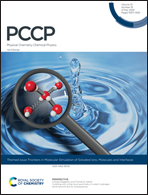Gas-phase Förster resonance energy transfer in mass-selected ions with methylene or peptide linkers between two dyes: a concerted dance of charges†
Abstract
Förster Resonance Energy Transfer (FRET) between a photoexcited and a ground-state dye is dictated by how far apart the two dyes are compared to the Förster distance. While there is a significant number of studies on the process for biomacromolecules in solution, there are only a few reports on gas-phase FRET. Here we report on a simple gas-phase model system, synthesized with the rhodamine 575 (R575+) and rhodamine 640 (R640+) FRET pair and a covalent linker with four methylenes, R575+-(CH2)4-R640+. Each dye carries a positive charge which allows for mass-spectroscopy experiments. We have recorded gas-phase dispersed fluorescence spectra of the mass-selected dications excited at different wavelengths using the homebuilt LUNA (LUminescence iNstrument in Aarhus) setup and find in all cases that emission is exclusively from the R640+ acceptor dye. The linker does not interfere electronically with the dyes and simply acts as a spacer. We can therefore establish the direct effect of the interaction between the two dyes when it comes to emission band maximum. Indeed, we find that R640+ experiences a significant shift in its maximum from 560 ± 1 nm for the monomer cation to 577 ± 2 nm in the presence of R575+, independent of initial excitation of R575+ or R640+. This redshift is ascribed to the large polarizability along the long axis of the xanthene core structure, and that this polarizability is larger in the excited state than in the ground state. Experiments were also done on a triply charged 11-mer peptide labelled with the same two dyes, R575+-(Gly-Gln)5-Lys-R640+ + H+ (Gly = glycine, Gln = glutamine, and Lys = lysine) where the extra positive charge is located on the peptide. Again a redshifted emission spectrum of the donor is observed with maximum at 582 ± 2 nm. Our work clearly demonstrates strong sensitivity of the photophysics of one dye to the nearby environment, and that caution is needed when using the energy transfer efficiency to infer dye-dye separations in gas-phase experiments.



 Please wait while we load your content...
Please wait while we load your content...